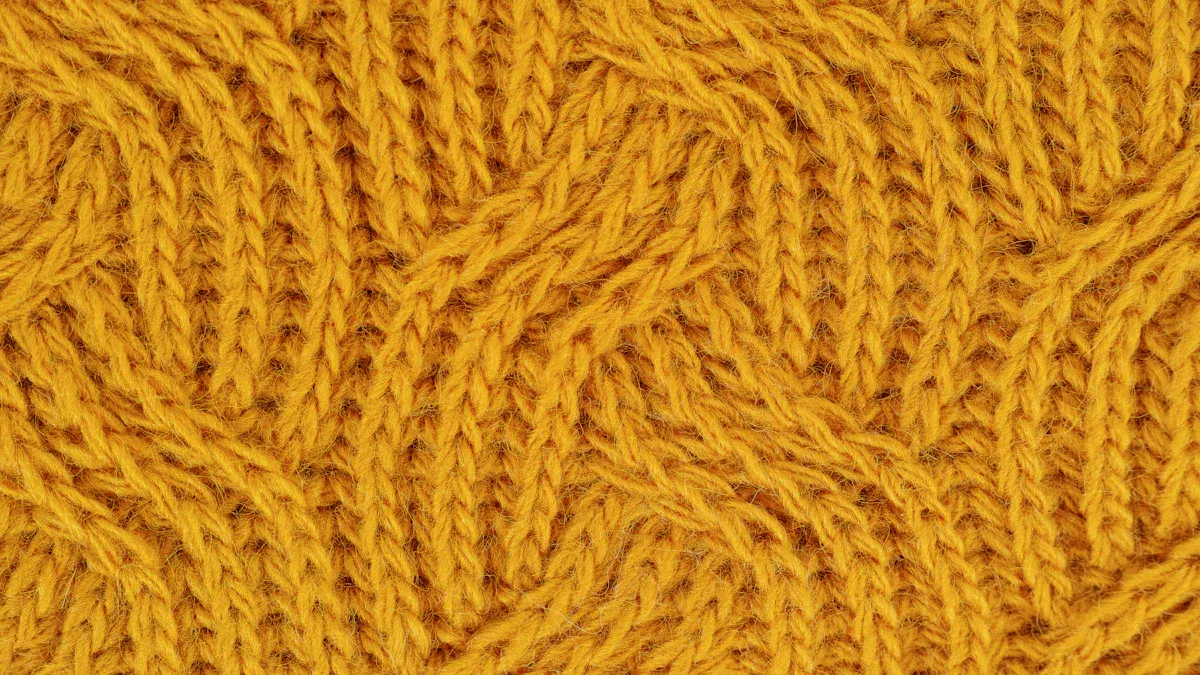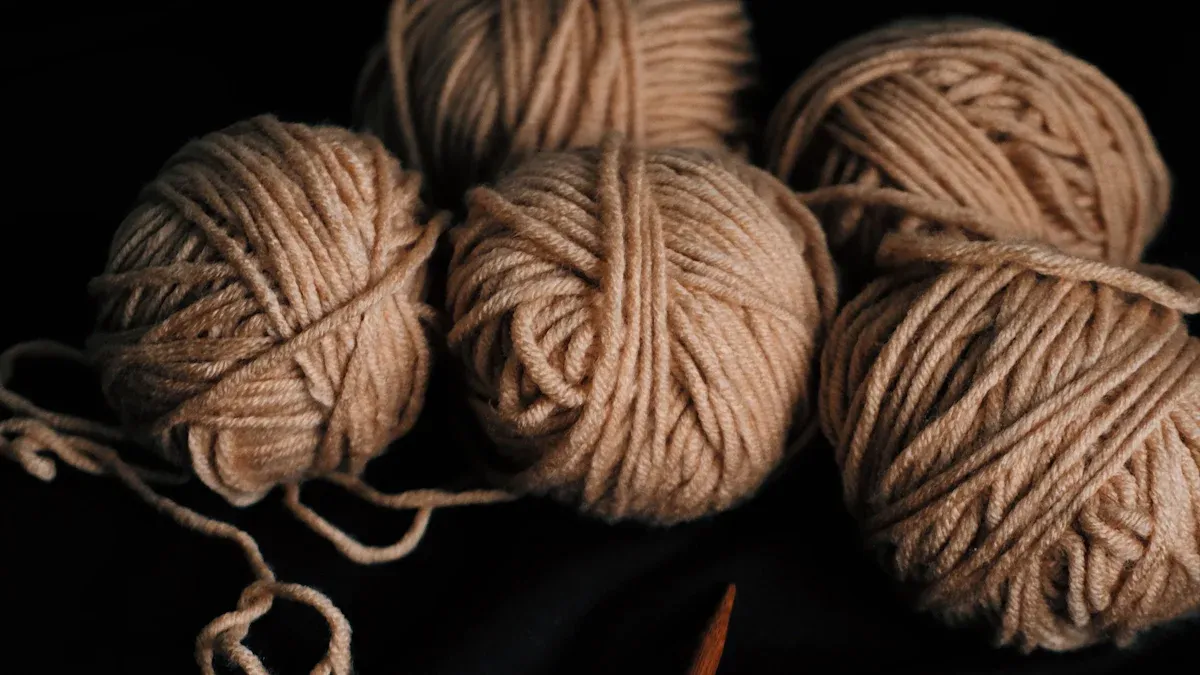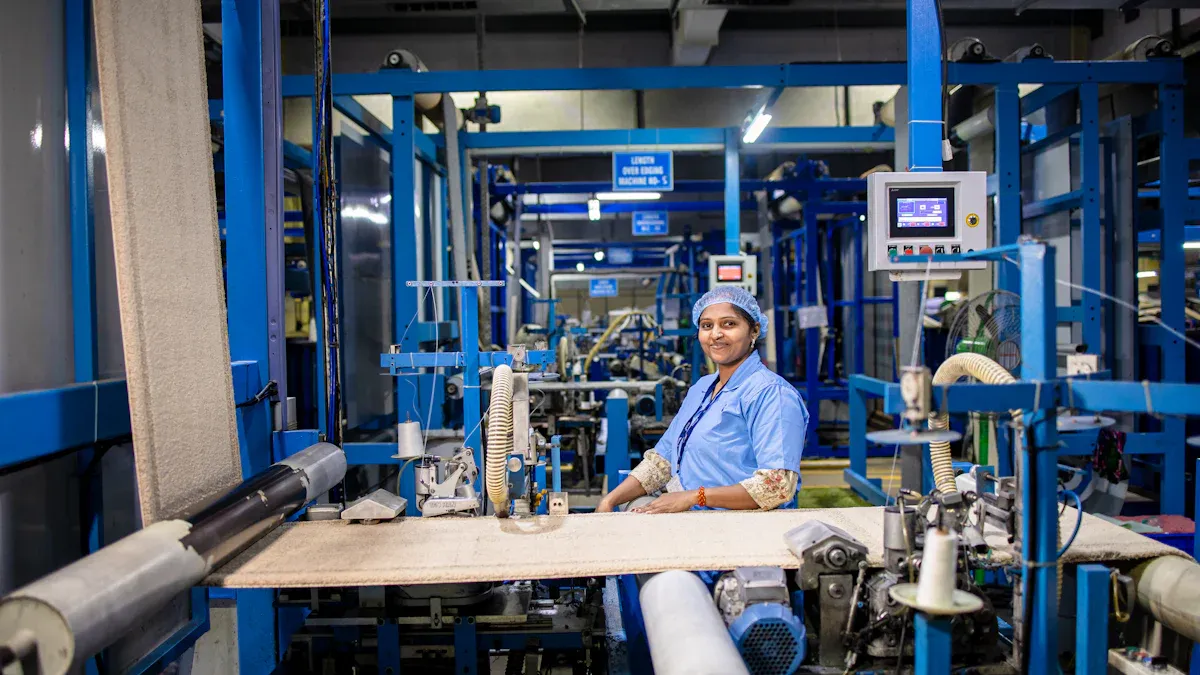 Double Knit stands as a technique that produces two fabrics at once. This method creates reversible, thicker, and warmer textiles. Knitters and textile enthusiasts value the history of these developments. Each milestone in double knitting reveals new possibilities for creativity and innovation in modern fabric design.
Double Knit stands as a technique that produces two fabrics at once. This method creates reversible, thicker, and warmer textiles. Knitters and textile enthusiasts value the history of these developments. Each milestone in double knitting reveals new possibilities for creativity and innovation in modern fabric design.
Key Takeaways
- Double knitting creates two layers of fabric at once, making textiles thicker, warmer, and reversible, which adds durability and style to projects like scarves and blankets.
- Historical and technological advances, from early hand techniques to industrial machines, have shaped double knitting into a versatile craft accessible to many.
- Modern double knit innovations include reversible patterns, colorful designs, sustainable materials, and online communities that support learning and creativity.
Foundations of Double Knit

Early Double Knit Techniques
Double knit techniques have deep roots in textile history. The earliest clear textual documentation appears in the 1800 knitting textbook “The art of knitting in its full extent” by Johann Friedrich Netto and Friedrich Leonhard Lehmann. This book includes a chapter that describes knitting two socks at once, one inside the other, using five needles. The detailed instructions show that double knit methods were already established by 1800. This early reference highlights how knitters valued efficiency and innovation even in the pre-industrial era. Physical evidence predates written records. A sock from North Africa, dated between 1100 and 1300 AD and housed in the Victoria and Albert Museum, demonstrates double-needle knitting. The sock features blue and white abstract designs and likely used needle size changes for shaping. This artifact proves that double knit techniques existed centuries before their first written description. The combination of textual and physical evidence reveals a long-standing tradition of double knit craftsmanship.
Note: Early double knit methods allowed artisans to create reversible, durable, and warm fabrics, setting the stage for future developments in textile design.
Double Knit in the Middle East and North Africa
Archaeological discoveries in the Middle East and North Africa provide further insight into the origins of double knit. A fragment of a knitted sock from Egypt, dated between 1100 and 1300 CE, stands as the earliest known example of true double-needle knitting. This sock, created during Islamic rule, displays a blue and white abstract pattern reminiscent of Islamic ceramics. Its construction involved knitting in the round and shaping with different needle sizes, demonstrating advanced double knit techniques. Historical sources and textile fragments from this region support the idea that the Middle East and North Africa served as the birthplace and early hub for knitting. Coptic Christian socks from Egypt, dating back 1,700 years, show early single-needle knitting. Other fragments from Eastern Syria reveal nalbinding, a precursor to knitting. The oldest true double knit examples, such as the sock in the Victoria and Albert Museum, align with Islamic artistic traditions and Arabic artisanship. Additional finds include knitted pieces with Arabic inscriptions and motifs, reinforcing the cultural and geographical origins of double knit in this region.
Industrial Revolution and Double Knit Machines
The Industrial Revolution transformed double knit production. Several key inventions enabled the mass production of double knit fabrics:
- In 1857, Arthur Paget patented the multi-head knitting machine, which allowed for complex knit structures.
- In 1865, Clay invented the double-headed latch needle, making purl stitch knitting possible and essential for double knit fabrics.
- In 1878, Henry Griswold added a second set of needles to circular knitting machines, enabling rib and double knit fabric production.
Earlier, William Lee’s mechanical knitting machine, invented in 1589, revolutionized knitting by increasing speed and uniformity. The rise of circular knitting machines in the 19th century further improved efficiency. Matthew Townsend’s warp knitting machine, introduced in 1856, boosted fabric output. These advancements mechanized knitting, moving production from homes to factories.
- The introduction of mechanized knitting machines, such as the Bentley-Cotton frame, automated garment shaping and knitting. Factories powered by steam and later electricity allowed one operator to manage multiple frames, greatly increasing production capacity.
- The shift to factory-based production improved quality control and standardization. Hand skills remained important for specialized and luxury markets, showing a gradual transition rather than a complete replacement of traditional craft.
- Overall, these technological advances led to a significant increase in textile manufacturing output and greater technical specialization.
The Industrial Revolution marked a turning point for double knit, making it accessible to a wider audience and laying the groundwork for modern trends in knitwear.
Double Knit Innovations and Modern Trends

Reversible Double Knit Patterns
Reversible double knit patterns have become a hallmark of contemporary knitting. These patterns allow both sides of the fabric to display attractive designs, eliminating the concept of a ‘wrong’ side. Structurally, double knit fabrics link two layers together, using combinations of knit and purl stitches that lock the layers and prevent curling. This construction results in a heavier, more stable, and elastic fabric compared to single-sided knits, which often curl and have less shape retention. Reversible patterns excel in projects where both sides remain visible, such as scarves and blankets. Popular reversible double knit patterns in modern knitting communities include:
- Nautical Stitch: A beginner-friendly weaving stitch with a cable-like appearance.
- Bubble Wrap: Features rows of bubbles and indents for a playful texture.
- Seed Stitch: Offers a simple, fully reversible option for novices.
- Pretty Parallelograms: Modern geometric chevrons for a bold look.
- Irish Moss: A four-row repeat that creates a plush, squishy texture.
- Checked Rose Brioche Stitch: Two-tone pattern with inverted sides.
- Grid Stitch: Combines knit and purl stitches to form a grid.
- Half Daisy Stitch: Ideal for afghan squares.
- Truly Reversible Travelling Cables: Fully reversible cable designs.
These patterns provide versatility and creativity, making them favorites for knitters who value both function and aesthetics.
Reversible double knit patterns stand out for their stability, warmth, and the beauty of having no ‘wrong’ side, making them ideal for a wide range of projects.
Colorwork in Double Knit
Colorwork has experienced significant innovation in double knit over the past two decades. Designers have introduced new techniques that expand the creative possibilities of color and pattern. Notable advancements include:
- Fusion and Fission Knitting by Mary Martin, which creates reversible colorwork designs on both sides of the fabric.
- Roosimine (Roositud) Knitting, an Estonian inlay technique that wraps contrasting yarns to form geometric patterns and textures.
- Typographic Knitting by Rüdiger Schlömer, which explores letterforms and text through colorwork methods similar to double knitting.
- Twigg Stitch Knitting by Vicky Twigg, a reversible ribbing technique for color patterns.
- Bargello Knitting by Patty Nance, which uses planned pooling of variegated yarns to create unique color effects.
These innovations emphasize reversible designs and complex color patterns, allowing knitters to experiment with new forms of visual expression. Pattern books such as “Mastering Color Knitting” by Melissa Leapman have helped popularize these techniques, offering clear instructions and inspiration for both beginners and advanced knitters.
Double Knit in 20th Century Fashion
Double knit fabrics played a pivotal role in 20th-century fashion. Designers embraced the fabric’s stability, warmth, and versatility. During the 1960s and 1970s, double knit polyester became synonymous with modern, easy-care garments. The fabric’s ability to hold shape and resist wrinkles made it a favorite for suits, dresses, and sportswear. Iconic patterns such as the Art Deco Coat and the Twice as Nice Sweater, published by Schoolhouse Press, reflect the era’s enthusiasm for bold colorwork and geometric motifs. Double knit’s adaptability allowed designers to experiment with structure and silhouette, influencing both high fashion and everyday wear.
Advances in Yarn and Tools for Double Knit
Technological advancements have transformed double knit production. Modern double knit machines, including flat-bed and circular models, use two sets of needles to improve yarn efficiency and enable complex garment shaping. Features like integral knitting allow entire garments to be produced with minimal seams, reducing waste and enhancing fit. Innovations such as racking enable precise panel shaping, while automated yarn carriers and defect detection systems increase productivity and quality. Machines like the Shima Seiki SWG-XR have set new standards for speed and precision, enabling seamless garments and intricate patterns. These tools have elevated the quality and efficiency of double knit work, making advanced designs accessible to a broader audience.
Double Knit Patterns and Publications
Published double knit patterns have evolved in both complexity and style. Early 20th-century patterns often featured simple horizontal color bands and straightforward construction. Over time, designers introduced more intricate motifs, including vertical bands, Art Deco panels, and lace elements. Some patterns combined stranded colorwork with intarsia, showcasing technical innovation. Accessories like the “Helen” tam used novel assembly methods, while garments such as the “Ethel” camisole demonstrated stylistic expansion beyond traditional motifs. The tradition of double knit remains dynamic, with knitters freely introducing variations and personal touches. Pattern books and online platforms continue to inspire creativity, reflecting a living tradition that values both heritage and innovation.
Online Double Knit Communities and Tutorials
The rise of online communities has revolutionized how knitters learn and share double knit techniques. Platforms like Ravelry host thousands of patterns, project galleries, and discussion forums. Knitters exchange tips, troubleshoot challenges, and celebrate finished projects. Video tutorials on platforms such as YouTube provide step-by-step guidance, making advanced techniques accessible to learners worldwide. Social media groups foster a sense of community, encouraging collaboration and the sharing of new ideas. These digital spaces have democratized knowledge, allowing knitters of all skill levels to participate in the ongoing evolution of double knit.
Tip: Engaging with online communities can accelerate learning and provide inspiration for your next double knit project.
Sustainable Double Knit Practices
Sustainability has become a central concern in modern double knit projects. Knitters increasingly choose eco-friendly materials such as organic cotton, linen, hemp, bamboo, and responsibly sourced wool. These fibers are biodegradable, require less water, and have a lower environmental impact than traditional synthetic options. Upcycled materials like Recover™ cotton and rPET (recycled polyester) add durability while reducing waste. Sustainable practices also include careful project planning to minimize leftovers, using techniques like Russian joins to reduce yarn waste, and selecting tools made from renewable resources such as bamboo.
- Organic cotton: Grown without harmful chemicals, biodegradable.
- Linen and hemp: Minimal water use, pest-resistant, biodegradable.
- Bamboo: Antibacterial, low water usage, biodegradable.
- Sustainably sourced wool: Durable, biodegradable, animal-friendly.
- Upcycled cotton and rPET: Reduce landfill waste, maintain softness and durability.
Sustainable double knit practices contrast with traditional methods that rely on petroleum-based synthetics and chemical dyes. Eco-friendly dyeing and renewable tools further reduce environmental impact, making double knit a responsible choice for environmentally conscious crafters.
Recent developments have transformed the craft by enhancing durability, stability, and versatility.
- Designers now create intricate patterns for both luxury and activewear.
- New techniques produce reversible fabrics, 3D textures, and multi-color designs.
- Beginners can access video tutorials, online communities, and local classes for support and inspiration.
FAQ
What makes double knit fabric different from regular knit fabric?
Double knit fabric features two layers joined together. This structure creates a thicker, reversible, and more stable textile compared to single-layer knits.
Can beginners learn double knitting easily?
Many beginners find double knitting approachable. Clear tutorials and simple patterns help new knitters build confidence and master the basics quickly.
Which projects work best for double knitting?
- Scarves
- Blankets
- HatsThese items benefit from double knitting’s warmth, reversibility, and durability.
Post time: Jul-31-2025